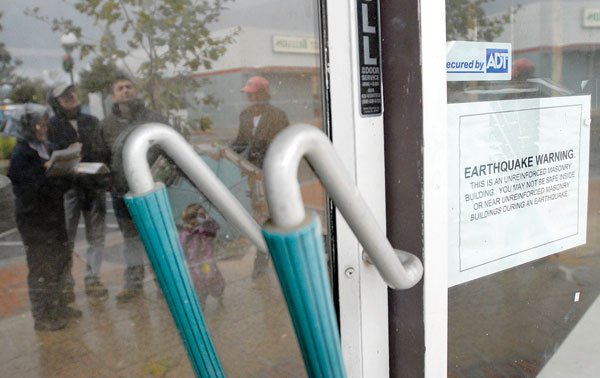
An unsafe chunk of downtown buildings is one step closer to
coming down.
An unsafe chunk of downtown buildings is one step closer to coming down.
Local builder Steve Ashford has spent the past eight months working with the city and property owners, trying to coordinate the demolition and rebuilding of four old, narrow buildings stretching from 7511 to 7525 Monterey St. They all share common walls and have to come down together, or not at all, because the city council passed an ordinance more than a year ago requiring the repair of old buildings prone to crumbling in an earthquake.
“This demolition request is delaying the start of three other approved projects,” City Planner Laura McIntyre told the council Monday night before the body approved the linchpin demolition request for the building in the middle of the pack at 7515 Monterey St. Now Ashford has to get a building permit and then he can start knocking part of the block down.
Despite financial incentives such as fee waivers, though, most of the city’s “unreinforced masonry buildings” remain in disrepair. Only seven of the city’s 37 known URM buildings have been fixed – either by repairs or demolition and reconstruction – and 13 of the remaining 30 buildings (including the four mentioned above) are in the city’s queue with their owners securing necessary permits, according to Development Center Manager Kristi Abrams.
City officials point mainly to ill-informed and uncooperative property owners for the low completion rate, but Ashford said the city’s under-staffed planning department, double standards and unrealistic demands from historical buffs have slowed projects.
Earlier this year Ashford had to convince the planning commission that he should not have to hire an archeologist for about $20,000 to be on site during the demolition of 7511 Monterey St., which the Historical Heritage Committee recommended he do with a 3-0-2 vote at its Dec. 19 meeting. The property at 7517 did not have to fight an archeologist requirement before getting its demolition permit, Ashford argued.
Eventually the planning commission and city council agreed, and the latter removed the requirement and simply mandated that Ashford have a photographer on hand from the city museum during the demolition to document anything significant. The same applies for the latest property at 7515, which Ashford will rebuild in the current building’s spitting image, just as he will with the 7511 building.
There are many different rules that determine whether a URM building needs to go through the HHC or stricter measures, but because most downtown buildings lie within the city’s historic district, URMs within the area require HHC and planning commission review after securing a planning permit, according to McIntyre. Then comes city council approval and, finally, a building permit before actual demolition takes place. Abrams said it can take anywhere from a few months to a year for a property owner to get through city paperwork depending on their neighbors and that particular property’s history.
Gilroy also has three “historic building sites” within the protected district, each of which requires an environmental impact report and council approval thanks to state regulations. None of the three are in the city’s repair queue yet, according to Abrams. For every month URM owners fail to start the repair or demolition process, they lose financial incentives. The city will impose a $10,000 per month fine on owners who do nothing by January 2010.













